Economic Report on Scottish Agriculture 2015
Economic Report on Scottish Agriculture 2015 presenting an overall picture of Scottish agriculture using data from the various agricultural surveys that RESAS manage.
5.5 Poultry
There were 14.74 million poultry on agricultural holdings in Scotland in June 2014. Numbers, which are only available since 1946, increased in the 1970s, and have fluctuated since then, generally between 12 million and 15 million.
Chart 5.23: Number of poultry in Scotland 1946-2014
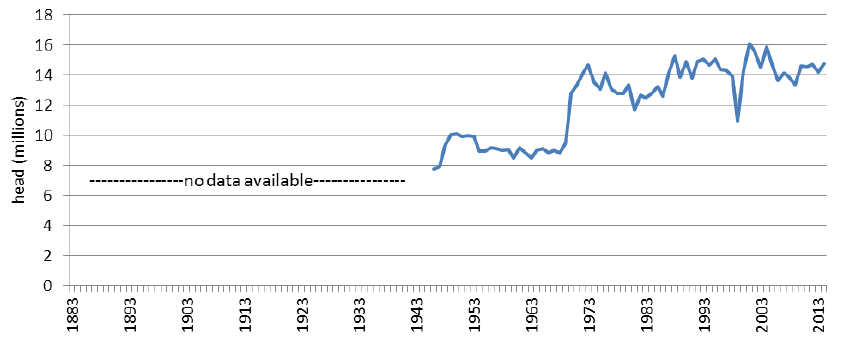
5.5.1 Distribution of poultry (Table C10(i), C10(ii))
Chart 5.23 shows that 83 per cent of poultry were located in the East of Scotland, in Tayside, Grampian, Scottish Borders, Fife and Lothians, with each sub-region accounting for between 13 per cent and 22 per cent of the Scottish total.
5.5.2 Poultry flock size (Tables C17, C18)
The poultry sector is highly concentrated. In June 2014, two per cent of poultry holdings accounted for 98 per cent of fowls laying eggs for eating (134 holdings with more than 1,000 fowls for laying eggs for eating, with 5.61 million birds). Conversely, 79 per cent of holdings with fowls for laying eggs accounted for just 0.7 per cent of birds (4,836 holdings with fewer than 20 laying fowls, with 38,100 between them).
There was also a similar pattern for breeding fowls, with three per cent of holdings accounting for 89 per cent of the 975,000 breeding fowls in Scotland (32 holdings with 870,000 birds).
5.5.3 Income from poultry (Table A6)
Poultry accounted for about three per cent of output from farming. The value of £100 million has increased by 16 per cent since 2004 (see chart 5.1). Income increased by £32 million (37 per cent) between 2004 and 2013, with large increases occurring in 2009 (£14 million), 2011 (£12 million) and 2012 (£12 million), due to a combination of higher prices and an increased volume of meat production. There was a £18 million decrease in 2014.
Poultry production (chart 5.2) decreased steadily between 2004 and 2008, from 124,000 tonnes in 2004 to 89,000 tonnes in 2008 (a 24 per cent fall). This was followed by marginal increases in most years until 2012. Falls in 2013 and 2014 have seen the overall poultry production levels decrease to its lowest level over the decade, 26 per cent down on 2004. Chart 5.24 shows a similar pattern for just broilers.
Chart 5.24: Broiler production and average price, 2004-2014
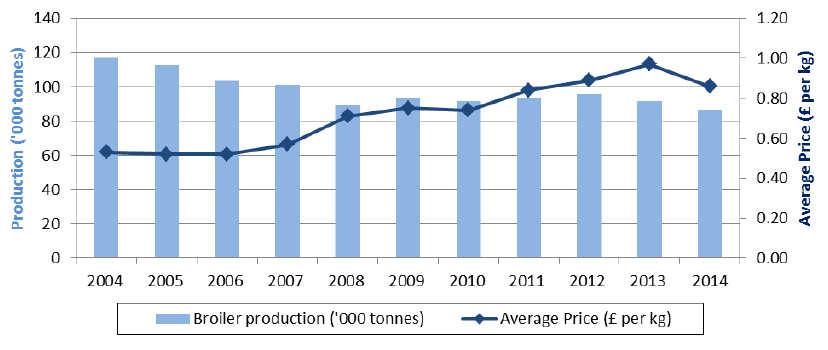
Prices have increased by 62 per cent between 2004 and 2014, up from an average of £0.53 per kg in 2004 to £0.86 per kg in 2014. There have been price increases in almost every year since 2004; the rise between 2012 and 2013 was around nine per cent, with a decrease of £0.11 per kg (11 per cent) in the last year.
5.5.4 Income from eggs (Tables A6)
Chart 5.25: Income from eggs, 2003-2013
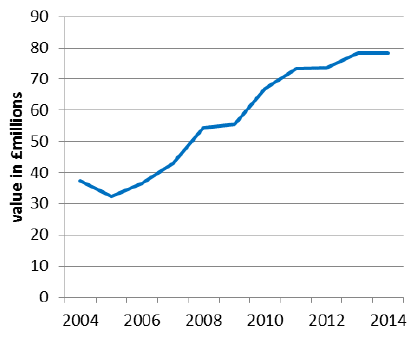
Income from eggs was estimated at £78 million in 2014, about 80 per cent of the value from poultry meat. The value has more than doubled since 2004, having risen steadily since 2005.
Egg production increased steadily between 2004 and 2009, from 866 million eggs to 907 million eggs, an increase of 41 million eggs (five per cent), with a larger increase between 2009 and 2014 of 224 million eggs (25 per cent), showing an overall increase between 2004 and 2014 of 265 million eggs (31 per cent).
Chart 5.26: Eggs for food - production and average price 2004 to 2014
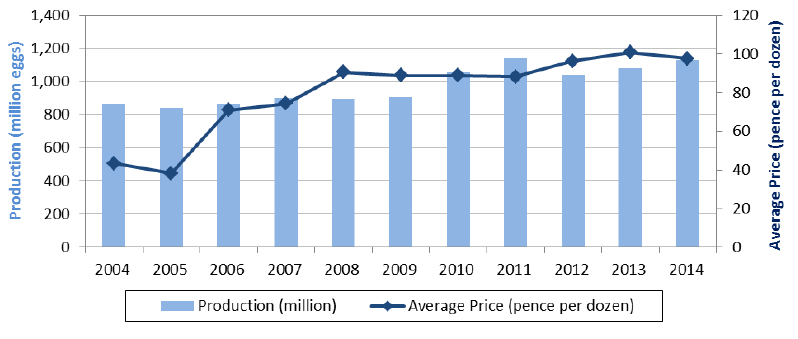
Since 2003, prices have risen from 41p per dozen to 66p per dozen (63 per cent) for eggs produced in laying cages and from 74p per dozen to 97p per dozen (32 per cent) for free range eggs.
Chart 5.27: Egg production method, 2004-2014
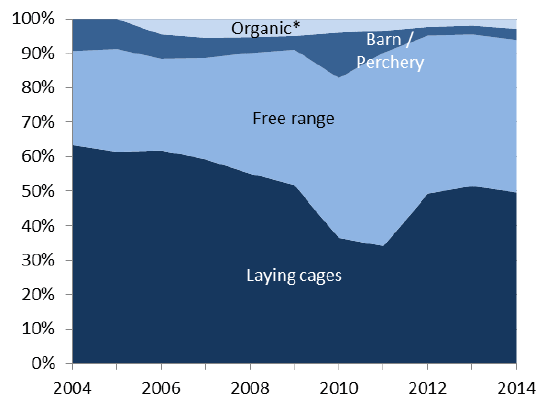
*data on organic not collected prior to 2006
Chart 5.27 shows the change in the method used to produce these eggs. In 2004 nearly two-thirds (63 per cent) of all eggs were produced in laying cages, whereas in 2014 there was a more equal split, with laying cages accounting for 50 per cent and free range for 44 per cent. In 2011 the proportion in laying cages fell to 34 per cent.
Contact
Email: Agricultural Statistics
There is a problem
Thanks for your feedback